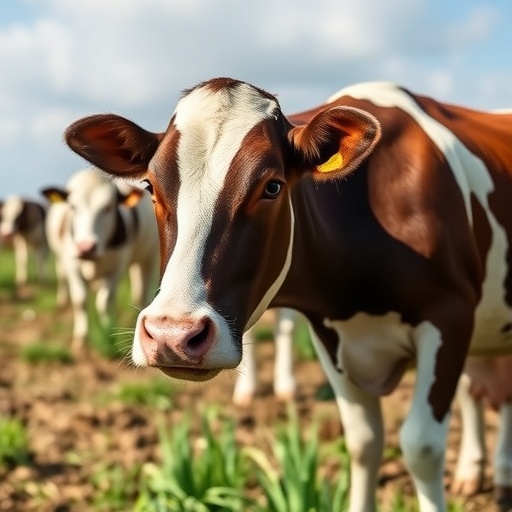
A groundbreaking study published in Science Advances has shed light on the profound and lasting impact of extreme heat on dairy production, revealing that rising temperatures driven by climate change pose a severe threat to one of the world’s most essential food sources: milk. By employing meticulous observational methods on a large dataset encompassing over 130,000 dairy cows across Israel for more than a decade, researchers uncovered that intense humid heat can slash milk output by up to 10 percent per day. This decline not only manifests immediately during heat exposure but extends for over ten days afterward, deeply undermining productivity and farm economics on a scale previously underappreciated.
Researchers chose Israel’s advanced dairy farming system as the ideal model for this study due to its representation of high milk-producing countries, combined with a diverse climate range that captures relevant temperature and humidity variations. This approach allowed the team to analyze the nuanced effects of wet-bulb temperature—a metric that integrates ambient air temperature and humidity, and more accurately indicates heat stress—on milk production. The “steam bath” conditions generated by elevated wet-bulb temperatures above 26°C (78.8°F) impose severe physiological strain on cows, disrupting metabolic processes critical for lactation.
The study emphasizes how the biological stress from this humid heat environment leads to a profound reduction in milk synthesis, with recovery periods exceeding ten days even after temperatures drop. The durability of this heat impact distinguishes it from transient weather disturbances, signaling a persistent risk in the face of expected global temperature increases. While traditional cooling adaptations such as ventilation and spraying have been widely adopted in Israel, these technologies only recoup around half the production losses experienced at moderately elevated wet-bulb temperatures of 20°C (68°F), and their effectiveness diminishes further as temperatures climb towards 24°C (75.2°F).
.adsslot_4zTm2JKH3R{ width:728px !important; height:90px !important; }
@media (max-width:1199px) { .adsslot_4zTm2JKH3R{ width:468px !important; height:60px !important; } }
@media (max-width:767px) { .adsslot_4zTm2JKH3R{ width:320px !important; height:50px !important; } }
ADVERTISEMENT
These findings carry significant implications for global dairy industries, especially in countries with climates similar to or warmer than Israel’s. The authors extrapolate these results to forecast that, by mid-century, without enhanced cooling methods, major milk-producing nations such as India, Pakistan, and Brazil could see per-cow milk output reduced by up to 4 percent on average. Conversely, these countries stand to gain the most from cooling technologies, underlining the urgent need for climate-adaptive infrastructure in vulnerable regions. However, even the most technologically advanced farms will face unavoidable productivity declines, highlighting an urgent call for more innovative strategies.
Beyond physical cooling interventions, the study advocates for integrated approaches that address broader animal welfare issues exacerbating heat sensitivity. Stressors like confinement and calf separation exacerbate the cows’ vulnerability by impeding their physiological resilience, thus compounding heat-related production losses. The researchers urge policymakers and the agricultural sector to invest in holistic management reforms that reduce cumulative stress, thereby enhancing animals’ tolerance to escalating climatic extremes.
From an economic perspective, the installation of cooling equipment remains a sound investment despite its partial efficacy. Farmers in this study recouped installation costs in just eighteen months on average, demonstrating practicality even under challenging environmental scenarios. However, researchers caution that the financial burden may limit adoption in less affluent dairy operations, potentially widening global inequalities in agricultural productivity and sustainability.
The meticulous methodology of this research—leveraging high-frequency, locally specific weather data linked with detailed production records—stands as a model for future climate impact assessments in animal agriculture. By precisely correlating humid heat exposure with milk yield decline in real-time, the study surpasses previous research relying on broad climatic averages, painting a more urgent and accurate picture of the challenges ahead. Such refined understanding is crucial to developing targeted adaptation policies that reflect varying local conditions worldwide.
Co-author Professor Ram Fishman highlights Israel’s dairy system as a global benchmark in technological advancement, suggesting that the severe impacts observed there might be even more pronounced in less equipped regions. This insight stresses the vulnerability of worldwide milk production as climate stressors intensify, potentially threatening food security for millions dependent on dairy products. The paper calls for an international response encompassing investment, research, and policy innovation to mitigate these risks effectively.
Additionally, climate change’s wide-ranging influence extends beyond the dairy sector, but this study is one of the first to rigorously quantify livestock-specific impacts at such granularity. Previous literature predominantly focused on crop yields, overlooking the substantial role animal agriculture plays in nutrition and economies globally. This research fills a critical gap, urging the scientific community and stakeholders to broaden their focus toward integrated assessment and adaptation planning encompassing both crops and animals.
The authors also articulate that while some adaptation strategies yield tangible benefits, they fall far short of fully counteracting heat stress. This limitation poses critical questions about future resilience, inviting exploration of emerging technologies, breeding for heat tolerance, and systemic changes in farm management practices. In light of predicted global warming trajectories, human innovation and policy support must accelerate to safeguard dairy production and, by extension, global food systems.
Ultimately, this seminal work redefines our understanding of climate change’s ramifications on agriculture by illuminating the intricate relationship between heat, humidity, cow physiology, and milk output. With escalating climate volatility predicted worldwide, the dairy industry confronts unprecedented challenges requiring immediate scientific, technological, and policy-driven interventions. As Dr. Eyal Frank remarks, the fate of the “cold glass of milk” on consumers’ tables hinges on the efficacy of collective efforts to adapt dairy farming sustainably under the shadow of a warming planet.
Subject of Research: Animals
Article Title: High-Frequency Data Reveal Limits of Adaptation to Heat in Animal Agriculture
News Publication Date: 4-Jul-2025
Web References: https://dx.doi.org/10.1126/sciadv.adw4780
References: Science Advances, DOI 10.1126/sciadv.adw4780
Keywords: Livestock, Dairy products, Heat waves, Climate change adaptation, Agriculture
Tags: climate adaptation in agricultureclimate change effects on dairy productiondairy farm economics under climate changeextreme heat impact on milk yieldhumid heat stress in cowsIsrael’s dairy farming practiceslivestock management in changing climateslong-term effects of heat on milk productionresearch findings on dairy cow productivityresilience strategies for dairy farmerssignificance of milk as a food sourcewet-bulb temperature and livestock health



